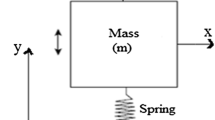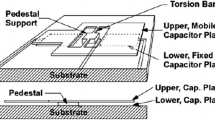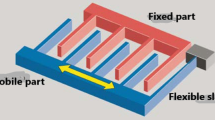Abstract
Vibration analysis is a conditional preventive maintenance technique that measures the level of vibratory motion by a measuring chain containing a vibration sensor, an amplifier and an FFT analyzer. In the present work, the vibratory analysis technique is improved on the basis of vibration sensor (capacitive sensor) developments. A suitable capacitive sensor mathematical model is developed thus; a formula of its mechanical sensitivity according to the capacitance is extracted. Experimental and simulation tests are conducted to validate the developed model. A damping rate equal to 0.68 is chosen to reduce the measurement error to a value not exceeding 0.5% in order to increase the accuracy to a value greater than or equal to 99.5%, consequently the sensor mechanical sensitivity is optimized. Finally, the simulation of the developed model is carried out for two capacitive sensors. The first sensor is used in the experimental tests and has a damping rate equal to 0.64 and the second is the sensor proposed in this work, having a damping rate equal to 0.68. The comparison of the obtained results has showed that the damping rate of 0.68 has greatly improved the capacitive sensor performances.










Similar content being viewed by others
References
Benmessaoud, M. (2014). « Conception et Modélisation des MEMS : Application aux Accéléromètres » Thèse de doctorat en électronique, Université des Sciences et de la Technologie d’Oran Mohamed Boudiaf, Décembre 2014.
Wang, J., et al. (2015). Design and analysis of a high sensitivity FBG accelerometer based on local strain amplification. IEEE Sensors Journal, 15(10), 5442–5449.
Zabit, U., et al. (2013). Design and analysis of an embedded accelerometer coupled self-mixing laser displacement sensor. IEEE Sensors Journal, 13(6), 2200–2207.
Bruant, I., Gallimard, L., & Nikoukar, S. (2011). Optimization of piezoelectric sensors location and number using a genetic algorithm. Journal Mechanics of Advanced Materials and Structures, 18(7), 469–475.
Xu, Y., Zhao, L., & Jiang, Z. (2014). A novel piezoresistive accelerometer featuring in-plane vibration. In 2014 IEEE International conference on electron devices and solid-state circuits (EDSSC), 18–20 June 2014, Chengdu, China.
Shoaib, M., Hisham, N., Basheer, N., & Tariq, M. (2016). Frequency and displacement analysis of electrostatic cantilever-based MEMS sensor. Analog Integrated Circuits and Signal Processing, 88(1), 1–11.
Cagatay, E., Köhler, P., Lugli, P., & Abdellah, A. (2015). Flexible capacitive tactile sensors based on carbon nanotube thin films. IEEE Sensors Journal, 15(6), 3225–3233.
Ali, A., Khan, A., Karimov, K.-S., Ali, A., & Khan, A.-D. (2018). Pressure sensitive sensors based on carbon nanotubes, graphene, and its composites. Journal of Nanomaterials, 2018, Article ID 9592610.
ALLIANTECH S.A.S. (2016). Technologie des capteurs capacitifs miniatures silicon designs. www.alliantech.com.
Ghemari, Z., & Saad, S. (2018). Piezoresistive accelerometer mathematical model development with experimental validation. IEEE Sensors Journal, 18(7), 2690–2696.
Reguieg, S. K., Ghemari, Z., Benslimane, T., & Saad, S. (2019). Modeling and enhancement of piezoelectric accelerometer relative sensitivity. SensingImaging, 20(1), 1–14.
Gorintin, L. (2011). « Etude et réalisation de transistors à nanotubes de carbone pour la détection sélective de gaz » Doctoral thesis on Micro and Nanotechnologies/Microelectronics, Ecole Polytechnique X, 2011, France.
Bakhoum, E. G. (2011). Ultrahigh-sensitivity pressure and vibration sensor. IEEE Sensors Journal, 11(12), 3288–3294.
Tse, C. (2013). Design of a power scalable capacitive MEMS accelerometer front end. Master’s Thesis degree of Applied Science Graduate, Department of Electrical and Computer Engineering, University of Toronto.
Acknowledgements
The authors like to thank the Algerian general direction of research (DGRSDT) for their financial support.
Author information
Authors and Affiliations
Corresponding author
Ethics declarations
Conflict of interest
The authors declare that they have no conflict of interest.
Rights and permissions
About this article
Cite this article
Ghemari, Z., Saad, S. The use of mechanical sensitivity model to enhance capacitive sensor characteristics. Analog Integr Circ Sig Process 99, 349–357 (2019). https://doi.org/10.1007/s10470-018-01383-w
Received:
Revised:
Accepted:
Published:
Issue Date:
DOI: https://doi.org/10.1007/s10470-018-01383-w




